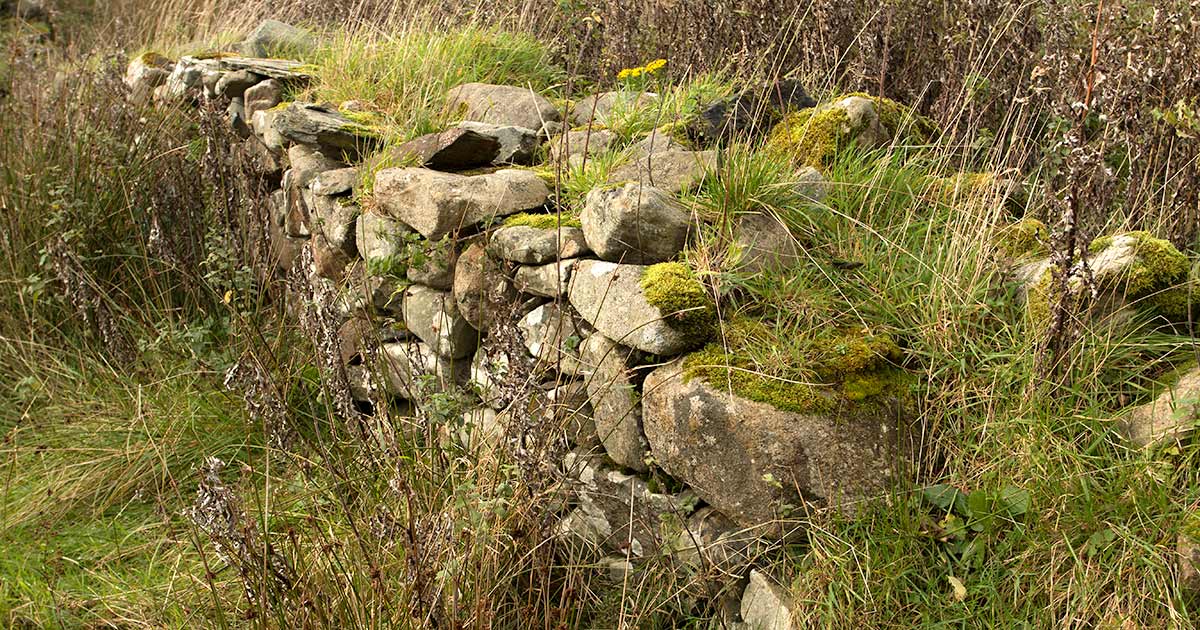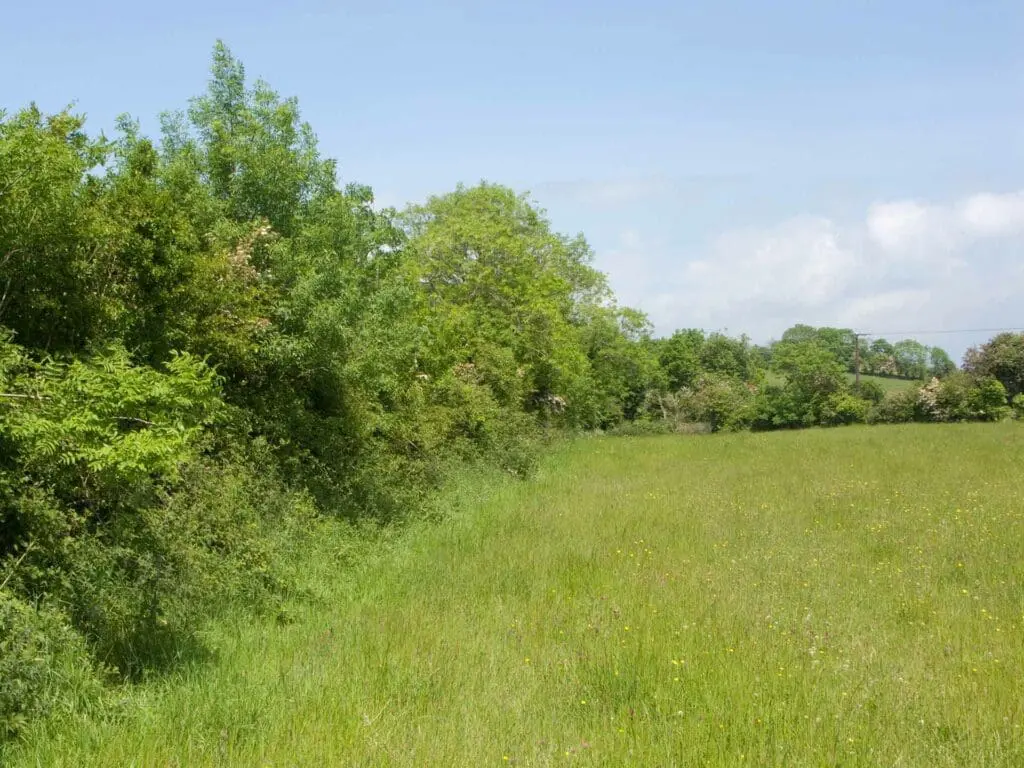Learn the art of dry stone walling…
Building with dry stone is one of the earliest skills developed by humans. Dry stone walls are durable because they contain no mortar, but are held together by the weight of stone, and by the skill of the builder who selected and fitted the stones together.
Dry stone walling involves either stripping and rebuilding existing walls that have fallen into disrepair, or gapping – repairing gaps where the wall has collapsed. Fewer new walls are built, although foundations sometimes have to be relaid.
Let’s look at the techniques.
Hands-on techniques for building a dry stone wall
Stripping out
Sort out the coping stones from the collapsed wall first and place them two to three metres from the wall.
Take out the main stones and put the top ones furthest from the wall. Keep the largest ones nearest the wall to aid building. Leave a gap of about 60cm alongside the wall for working. Keep throughstones safe and separate.
When stripping out a gap, step the ends to tie in the new wall.
Batter frames
Batter frames are used to ensure accurate work.
Set the frame(s) at the end(s) of the section you are working on and run guidelines along the wall. Make sure the lines aren’t moved by people working.
Foundations
The foundations or footings should be set in a trench a few centimetres wider than the wall, dug down to a firm base. They could be as little as 3cm up to 30cm deep depending on soil type.
Use the biggest stones, except those that are good for coping, wallheads or throughstones.
Place the long edges into the wall whenever possible.
Stones should be steady and unable to slip. Don’t use ones that need wedging. Avoid roundbacked stones that are hard to build on.
Pack between the footings with angular, freedraining hearting stones.
Courses
The wall is built up in horizontal courses (lines of stones of even height) for ease of construction, strength and appearance.
Use the biggest stones in the bottom of the wall and the smallest in the top. This produces a stronger wall and is easier to build.
Try to ensure that each joint in one course is bridged by a stone in the next course.
Place stones level or dipping outwards slightly and where possible with the long edge into the wall.
Hearting stones are important. Use solid angular stones. Place them carefully, almost as you would the face stones. Add hearting stones as you go, keeping them at or just below the level of the face stones.
Make sure people follow the designated batter of the wall. Try to keep the face of the wall smooth – it discourages climbers.
Place stones on the wall – don’t drop them and don’t hammer on the wall otherwise you will dislodge other stones.
Throughstones
Throughstones located at regular intervals straddle the wall, holding the two sides together to stop it bellying out and collapsing. They are essential for the wall’s strength. They can be slightly longer than the wall’s width, but must not be shorter as this makes the wall less secure. Ensure that they pin all the stones below them. How many to use and where to put them depends on the regional style of wall and the type of stone.
Coping
Coping stones straddle the wall in the same way as throughstones, holding the sides together and holding down and protecting the upper courses.
There are many types of coping, so follow the local style as far as possible. Keep the top of the coping even by using a line. Avoid wedging the stones to keep them steady.
Wallheads
The wall head is a pillar which acts like a bookend to hold the wall up. It is the section least well supported and most prone to damage. Use the largest and most rectangular stones available.
Slopes
Build in horizontal courses. Grade the courses so that the biggest stones are near the hillside, but keep the course as level as possible. Start from the bottom and work uphill.
Gapping
Remove and sort all the unstable stones so that you have a firm base to work from. Sort the coping stones out first.
Step the ends of the gap so that you can tie in the new wall.
Look at the old wall to see how it was built and try to recreate its style. Use the old stone for rebuilding – don’t clean off old moss and vegetation and ensure any additional stone used is of the same type as the original.
Season
Generally spring and summer because it is difficult to stay warm in walling in cold weather.
Preparation and working with groups
Site visit
Visit the work site in advance to gain a clear idea of what you will be doing on the day. If working for a client, meet with them on site to discuss the project. Assess the suitability of the project for the group you will be leading and the time available.
Consider the following questions: What resources are required for the project and who will supply and deliver them? Are there any access difficulties? Consult plans or drawings to establish the location of underground services.
Undertake a risk assessment for both project and site.
Tools & equipment
Depending on the size of the team adjust the quantity of equipment taken to site. Ensure the tools are in good condition before using them.
Here is a list of the tools and equipment you might need:
- First aid kit
- Appropriate protective gloves
- Impact grade goggles
- Tape measure
- Lines and pegs
- Line and spirit level
- Fencing pliers
- Batter frame (already made according to wall specifications)
- Walling, sledge, club and claw hammers
- Chisels (including bolster chisels)
- Garden spades
- Crowbar
- Mattocks
- Buckets
- Wheelbarrows
- Bowsaws
- Site safety signs
Ensure all team members are wearing appropriate footwear and clothing and issue the specified safety equipment.
Introduce the site, the work and the reasons for doing it. Walk around the site explaining what work will be undertaken. Identify potential hazards and explain how to work safely around them.
Demonstrate tool use
Demonstrate and explain the safe use, carrying and on-site care of the tools before starting work.
Demonstrate work techniques
Demonstrate all new work techniques as you come to them. This will save mistakes and avoid accidents.
Plan the movement of stone to avoid lifting and to use whellbarrows where possible.
Demonstrate the correct lifting technique (bending the knee and keeping the back straight so that the leg muscles are used and the back is not strained).
Organisation of team
Talk about how a wall is built, show everyone an existing piece of wall, point out the details of construction and identify and describe the regional style.
Divide the team into pairs, teaming beginners with experienced wallers. Allocate and mark a two to three metre section of wall per pair, one person on either side. A group of 12 should be able to build around four to six metres of wall per day.
Leave some people free to collect ‘new’ stone from surrounding site and ensure that the different types of stones are evenly distributed.
Stress the basic rules:
- Each stone should rest on two others and two should rest on it.
- Where possible put the longest length of stone into the wall.
- Keep the courses level and build up both sides at the same rate.
- Keep to the correct batter.
- Grade the wall – largest stones at the bottom, smallest at the top.
- Never hammer on the wall.
- Step back at regular intervals to see what the wall looks like.
- Always aim to cover any joints.
- The leader should check, assist and encourage people and ensure work standards are maintained.




